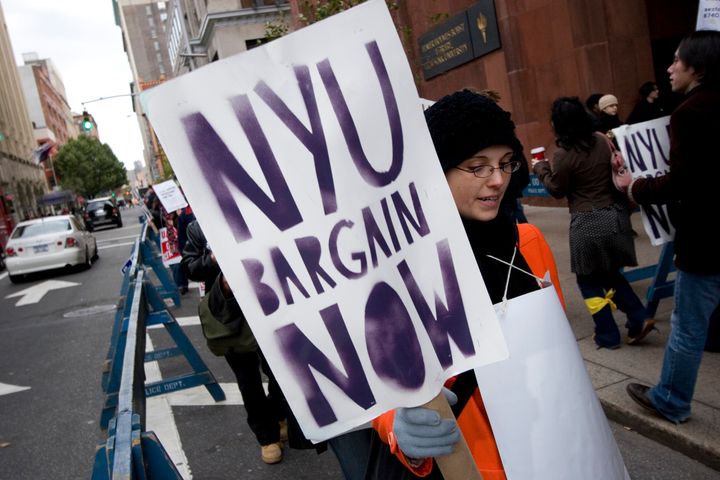50,000 Students In Higher Education Have Unionized In Just 2 Years
A wave of labor organizing has been washing through U.S. universities as graduate students and other workers form new unions on campus.
More than 50,000 students who work at U.S. universities have unionized over the past two years, the National Labor Relations Board announced Monday. The new bargaining units include graduate student teachers and researchers as well as undergraduate housing and dining employees.
Advertisement
The campaigns have led to some of the biggest union elections in years, adding to the ranks of the Service Employees International Union, the United Auto Workers and other unions better known for representing blue-collar employees. Though not as high-profile as organizing pushes at the likes of Amazon and Starbucks, the campus victories have been a bright spot for organized labor after decades of declining membership.
Last year, more than 3,000 student-workers at Cornell University joined the United Electrical Workers, while 1,600 at Emory University joined Workers United, the same union that now represents thousands of Starbucks baristas.
“The collegiate organizing efforts have gotten a boost from favorable policies at the NLRB, but those policies may not last following former President Donald Trump’s victory this month.”
This year, 1,400 student-workers at the California Institute of Technology and another 4,000 at the University of Pennsylvania joined the UAW. The Detroit-based union now includes around 100,000 workers in higher ed, amounting to about a quarter of its membership.
Advertisement
All told, there are 51 new unions formed on campuses since 2022, representing roughly 50,300 workers, according to the NLRB. For context, the Bureau of Labor Statistics estimates that the entire labor movement added 139,000 members last year, much of it likely due to hiring by employers that were already unionized.
The collegiate organizing efforts have gotten a boost from favorable policies at the NLRB, which oversees private-sector union elections. But those policies may not last following former President Donald Trump’s victory this month.

James Leynse via Getty Images
We Need Your Support
Already contributed? Log in to hide these messages.
In 2016, the then-Democratic majority on the labor board ruled in a case at Columbia University that students who teach and do research qualify as employees under the law and therefore have collective bargaining rights. The decision spurred new organizing efforts at schools where graduate students didn’t already have union representation.
A Republican-led board of Trump appointees later began an effort to reverse the Columbia case, but it failed to finish the job before another Democratic majority took over under President Joe Biden. However, Trump will have another chance to install new board members in his next administration, and they are not expected to be nearly as union-friendly as Biden’s.
Advertisement
If the agency ends up restricting union rights on college campuses, graduate students and other workers could still unionize — just not under the normal NLRB election process. They may end up trying to force universities to recognize their unions voluntarily, perhaps through strikes or other public pressure campaigns.
As HuffPost reported last week, Senate Democrats have an opportunity to reconfirm one Democratic board member to another term before Republicans take control of the chamber in January. Doing so would ensure a Democratic majority at the labor board into the second half of 2026, unless Trump were to fire the board and install new members after arriving at the White House.

Comments are closed.